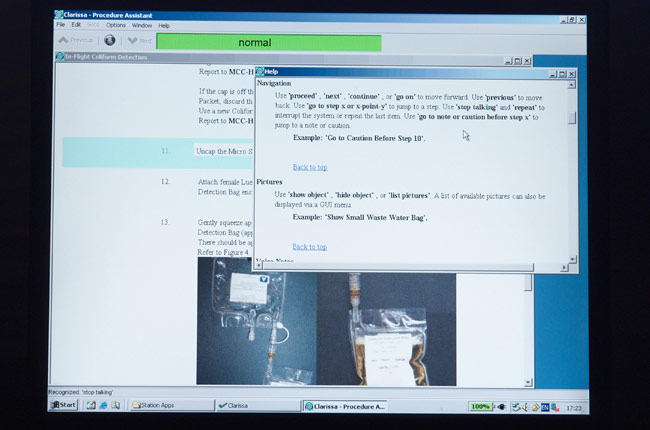Clarissa Explains it All

Many tasks astronautsperform on the International Space Station (ISS) are tedious, long and toocomplicated to do from memory. Often an astronaut needs to be read instructionsby another person, or constantly switch his attention from the task at hand toa laptop computer displaying a PDF of the instructions, to work.
Both of thecurrent methods have their disadvantages. One requires two people where only one is necessary; the other involvesa floating laptop and the potential to lose the pieces of whatever is beingworked on.
Engineersat NASA's Ames Research Centerfelt they had a solution to this problem: a speech-powered virtualassistant. Using suggestions fromastronauts, they developed Clarissa, the first spoken dialogue system in space,to provide crew members a hands-free means of getting technical instructions.
Clarissa'sparents believe that she will greatly improve the efficiency of some of thelonger tasks performed by crewmembers, including analyzing potable water androutine check-ups of the space suits.
At present,the program understands about 500 words, said John Dowding, a senior scientiston the project. Clarissa understandsabout 75 vocal commands - such as "go forward" or "go back" - related toreading procedures. Should she recommend the wrong step or misrecognize acommand, astronauts can correct her by saying "undo" or "no, I said go to ..." andthen say the step they wish to hear.
Clarissa isincluded in the standard software package included in each of the ISS clientlaptops, said Dowding. Astronauts onlyneed to connect a noise-canceling headset to the laptop to use the program. Therehas been work done in the past to incorporate speech-recognition software likeClarissa into a proposed Personal Satellite Assistant (PSA), an orb-shapedrobot that would hover aboard the station, working with the astronauts like apersonal roving laptop.
MannyRayner, a senior consultant on the project, is not optimistic about Clarissa'sfuture as an add-on to a PSA. "Inprinciple, it would be easy to make Clarissa accessible through the PSA, but myfeeling is that it will never happen."
Get the Space.com Newsletter
Breaking space news, the latest updates on rocket launches, skywatching events and more!
Clarissawas delivered to the ISS on Dec. 25, 2004 onboard the Progress16 supply ship and installed shortly after. However, the program has yetnot been tested in space, and the test date was pushed back due in part to thecurrent crew spending time on station repairsand preparing for spacewalks.
Althoughthe system hasn't been tested in space, its developers are confident it willwork based on successful test runs on Earth. Three quarters of the astronauts who have tried out Clarissa liked thetechnology, according to Rayner.
SinceClarissa's developers planned to set her up on the International Space Station(ISS), the team "went looking for names that had 'ISS' in them," saidDowding. "There aren't many ofthose. Clarissa won out," Rayner told Space.com, adding that the team thoughta woman's name would make the system sound friendly.
Clarissa getsher voice from one of her developers, Beth Ann Hockey, another reason forgiving the system a feminine name. Hockey recorded sound files of all the words Clarissa would need to say. While the intonation of individual wordsstrung together does not always sound natural, Clarissa speaks quite smoothly,according to Rayner.
The systemis not perfect, though. When in "open mic" mode, Clarissa gets confused about 10 percent timetrying to distinguish between direct voice commands and words not directed ather, such as those to other astronauts or mission control.
The team iscurrently modifying her software so she does a better job making thesedistinctions. By listening to thousandsof examples of people talking to her and people talking to other people,Clarissa will "learn to recognize artifacts and determine whether [she] isbeing spoken to by listening to subtle nuances," said Rayner.
Also, sheis currently only fluent in English - a problem since half the ISS's crew speaks primarily Russian. However, she has been programmed tounderstand a variety of English dialects, including Russian-accented English,said Dowding.
"Itunderstands Russian-accented English, but not as well as American English,"said Rayner. Teaching her Russian is"only a matter of recording enough Russian data and entering it into herprogramming."
As Clarissagrows more as a talker, scientists expect her to aid astronauts in many moreprocedures related to life support systems, medical exams, and equipmentcheck-out.
"We lookforward to increasing [Clarissa's capacity] to include all of the ISSprocedures, about 10,000 in all," said Dowding, who has a long term goal to"build computerized systems that can participate as equal partners in otherwisehuman-human conversations."
Join our Space Forums to keep talking space on the latest missions, night sky and more! And if you have a news tip, correction or comment, let us know at: community@space.com.
